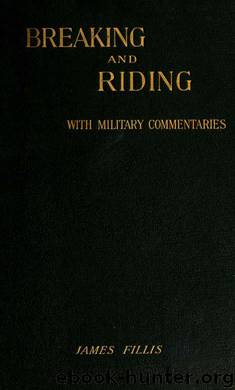Breaking and riding by Fillis James 1834-1913 & Hayes M. Horace (Matthew Horace) 1842-1904

Author:Fillis, James, 1834-1913 & Hayes, M. Horace (Matthew Horace), 1842-1904
Language: eng
Format: epub
Tags: Horses, Horsemanship, Horses
Publisher: New York : C. Scribner's Sons
Published: 1902-08-22T05:00:00+00:00
We should not try to get the horse to change his leg away from the wall, before making him do so, while going along it. The horse should also very readily start into the canter on the
* I again repeat that I always begin a new work at the end of a lesson.
t The difficulty is not in starting, but in keeping the horse at a uniform distance from the wall while holding him straight.
leg we wish, when we have placed him in the position to do so, and have given him the proper indication with the legs.* I then start him into the canter on the off fore, and keep him at it until he becomes quiet. I then walk him for a minute or two, and put him into the canter on the near fore, and keep him at it, the same as before, until he is light and quiet, after which I again walk him for some moments. Finally, I start him into the canter on the off fore, and so on. I therefore make successive starts at the canter, each one being on a different leg. Little by little I shorten the periods during which I let the horse walk between the starts at the canter, in such a way that he does not take, for instance, more than five, four, three, two, and finally, one step between the respective starts. At last he learns to start into the canter alternately from the stationary foot to the other foot, the starts being interrupted only by the halt.
Thus, the horse having been started into the canter on the off fore, is stopped, and is immediately started again into the canter on the near fore, this change of leg being helped by the halt. As the true change of leg is done without halting, it is called a change of leg in the air.
At this period of his training the horse is ready for the change of leg, which I ought to be able to make him do without upsetting him in the least. I start him into the canter on the near fore, while going to the right. He therefore canters on the outward leg,"|* and I support him at that time with the near rein and right leg, which gives a stronger pressure than the left leg. When I come to a corner of the school I completely change my " aids," and use the off rein and left leg. This
* Position by legs and hands and stimulation by the legs arc two most important principles in riding.
t In this case he is cantering "false," which is the term used by English cavalrymen. •
chani^e of " aids " ought to be done with great decision and perfect combination. In order for the movement to be well done, it should be executed with extreme quickness, and without the slightest jerk. . This quickness and smoothness are possible onl)- if the rider has constantly taken the precaution of
Download
This site does not store any files on its server. We only index and link to content provided by other sites. Please contact the content providers to delete copyright contents if any and email us, we'll remove relevant links or contents immediately.
Finding Gobi by Dion Leonard(2782)
Grumpy Cat by Grumpy Cat(2687)
A New Earth: Awakening to Your Life's Purpose by Eckhart Tolle(2597)
The Silkworm by Robert Galbraith(2443)
Tippi by Tippi Hedren(2184)
End of Days by Sylvia Browne(2118)
Total Cat Mojo by Jackson Galaxy(1968)
Backyard Chickens Beyond the Basics by Pam Freeman(1905)
The Animals Among Us by John Bradshaw(1831)
The Ultimate Pet Health Guide by Gary Richter(1729)
All Things Bright and Beautiful by James Herriot(1709)
Vet in Harness by James Herriot(1666)
Doggy Desserts: 125 Homemade Treats for Happy, Healthy Dogs by Cheryl Gianfrancesco(1655)
Dog Years by Mark Doty(1645)
Cesar's Way by Cesar Millan(1636)
Chicken Soup for the Ocean Lover's Soul by Jack Canfield(1602)
Dog Training 101 by Kyra Sundance(1560)
Walking with Peety by Eric O'Grey(1555)
Animal Speak by Ted Andrews(1514)
